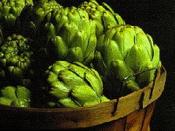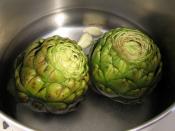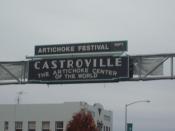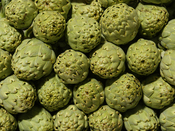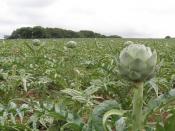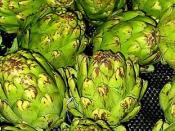ARTICHOKE When this paper was first discussed I was really hoping that you would assign a topic for us. I never felt such a fondness or appreciation for a type of food to do a research paper on the topic. I began to think about it for a few days, pondering some of my favorite fruits and vegetables, unable to come to a decision. I finally had the idea that perhaps I shouldn't be researching a product that I already know about, instead I should use the opportunity to become more familiar with something new to me. So instead of thinking of my favorites I started thinking of things I've always wanted to try, but never had the opportunity. I thought what about the artichoke? I was curious, so I said why not, and that's how I arrived at my topic.
Historically artichokes are native to the Mediterranean region. Today all of the artichokes grown commercially in America are from California. Artichokes prefer climates that never reach too hot or too cold. Where they are grown the winters are frost free and the summers are cool and moist with fog. Nearly ten thousand acres were devoted to artichokes in California and the crop value exceeded $46 million for the 1997-1998 season. Monterey County contains the most artichoke acreage of any county, rightfully so naming the artichoke the Official Vegetable of Monterey County. The "Artichoke Center of the World"ÃÂ, or Castroville is small community of five thousand people. Despite they're population 75% of all artichokes are grown in or around the town.
Artichokes are an extremely labor-intensive crops because artichokes must be harvested completely by hand. Also they must be harvested every seven days during peak season because artichokes on the same plant mature at different times. 40-60 percent of the growing costs are due to the high cost of labor.
There is nothing fast about the artichoke. It is highly unlikely they'll every be apart of a fast food menu. Artichokes do take some preparation. First they must be washed under cold running water. Then you must pull off the lower petals and cut off the stems. Next cut off the tip and if you like trim the petal tips. Artichokes tend to lose they're color quickly, therefore they should be dipped in acidified water when you are done preparing them.
Now to cook an artichoke you can either boil or steam them. When boiling an artichoke you should put the artichoke in boiling water, return to a boil, and reduce to a simmer for 25-40 minutes. The cooking time will vary with the size of the artichoke. When the petals near the center pull out easily the artichoke is done. In order to steam artichokes place them on a rack over an inch or so of boiling water. Use a generous amount of salt, cover and cook for 25-40 minutes. Many people eat artichokes whole, but they can be nice additions to stir-fry or pasta dishes. Artichokes have an excellent price/value ratio because they are affordable, but are received as a quality product. This gives the chef the opportunity to set his own price.
The health factor is very much on the side of the artichoke industry. The Mediterranean is known for its long life expectancies and low rates of chronic disease. And as I mentioned earlier, artichokes are native to the Mediterranean region. "One large artichoke contains only 25 calories, no fat, 170 milligrams of potassium, and is a good source of vitamin C, folate, magnesium and dietary fiber."ÃÂ Be sure to use low fat dressings, sauces, and dips so your effort to diet isn't wasted.
Artichokes are harvested year round with peaks in the spring and in the fall. The peak season is from March to May, and to a lesser degree in October. There are four main varieties of artichokes; the green globe artichoke, the desert globe artichoke, the big heart artichoke, and the imperial star artichoke. The green globe artichoke is a year-round variety. Its globe-shaped in winter and spring, and conical in summer and fall. They are green in color with some purple at base in the summer. The desert globe artichoke is a winter and early spring variety. The shape varies conical to round, green in color, with thorn, not prominent. The desert globe peaks from January to march. They are from the southern California inland desert valleys. The big heart artichoke are a thornless variety. The shape is generally conical, wide based, with green color and purple more pronounced in summer. The big heart artichoke is nearly year-round availability, with peak months of march, June, September, and October. The imperial star artichoke is a year-round thornless variety. It has a glossy green color and is generally conical with seasonal variations.
In my research I found much about the artichoke that I was previously unaware of. I found that there are many uses for the odd shaped vegetable, and how to prepare it. Previously I had only been able to open the can and quarter the artichokes for my Mise en Place. I found how the majority of the artichokes come from an area around a small town in California. I also found how difficult it was to harvest the vegetable, even harder than it is to prepare. I found out about their peak times and the different types of artichokes. I'd have to say that I learned pretty much in my research, untill recently I only knew what an artichoke looked like.
RESOURCES California Artichoke Advisory Board http://www.artichokes.org
